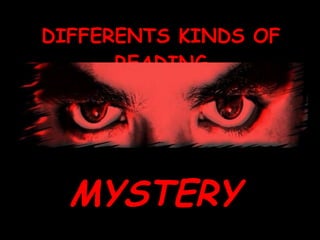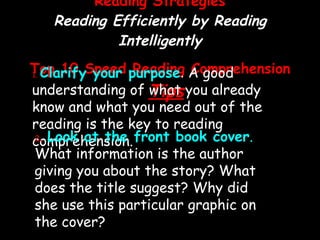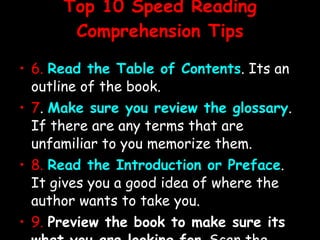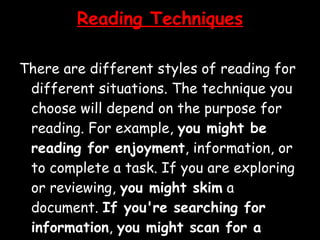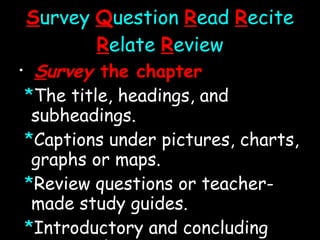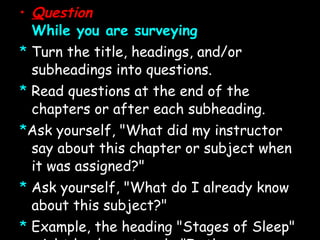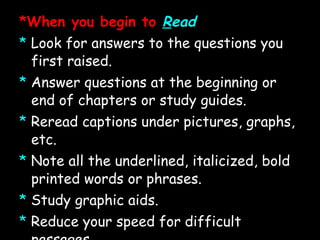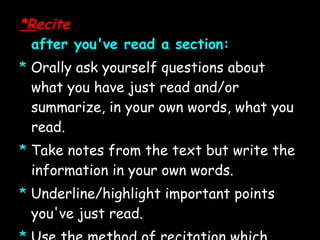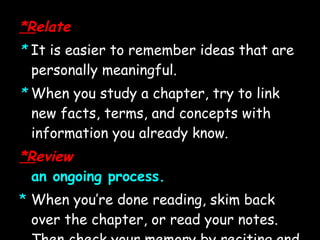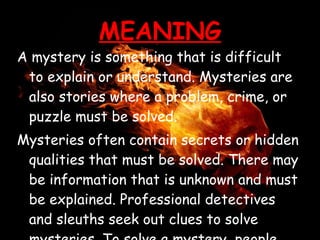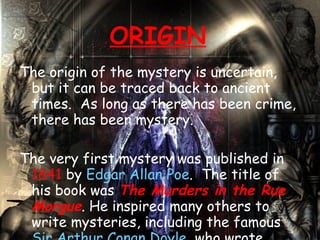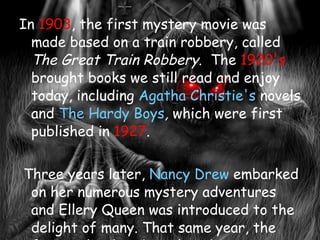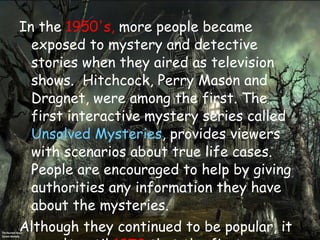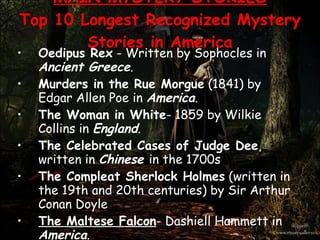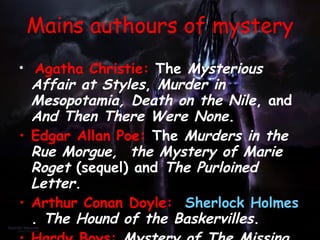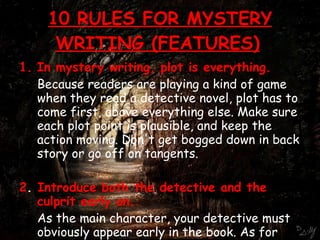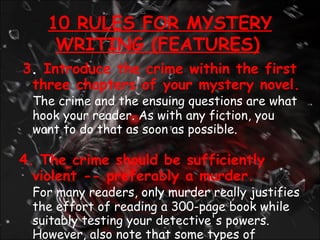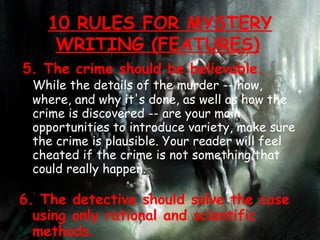Mystery
- 1. DIFFERENTS KINDS OF READING MYSTERY
- 2. Reading Strategies Reading Efficiently by Reading Intelligently Top 10 Speed Reading Comprehension Tips 1. Clarify your purpose . A good understanding of what you already know and what you need out of the reading is the key to reading comprehension. 2 . Look at the front book cover . What information is the author giving you about the story? What does the title suggest? Why did she use this particular graphic on the cover?
- 3. Top 10 Speed Reading Comprehension Tips 3 . Read familiar material . When you first learn to Speed Read, use books and articles on subjects you have some familiarity with or subjects you have come across before but havent reviewed recently. Later on, you can challenge yourself with new material. 4 . Make Predications . Can you make any predictions about the story with the information youve already gathered? 5 . What have the experts said about the book or author? Look at the back cover. What are the comments being made by critics whove read the book? What other clues can you pick up?
- 4. Top 10 Speed Reading Comprehension Tips 6. Read the Table of Contents . Its an outline of the book. 7 . Make sure you review the glossary . If there are any terms that are unfamiliar to you memorize them. 8. Read the Introduction or Preface . It gives you a good idea of where the author wants to take you. 9. Preview the book to make sure its what you are looking for . Scan the headings and subheadings. 10 . Read the topic sentences . Remember that the first and last sentences of a paragraph give you the essence of that paragraph, especially when reading non-fiction.
- 5. Reading Techniques There are different styles of reading for different situations. The technique you choose will depend on the purpose for reading. For example, you might be reading for enjoyment , information, or to complete a task. If you are exploring or reviewing, you might skim a document. If you're searching for information , you might scan for a particular word . To get detailed information, you might use a technique such as SQ4R . You need to adjust your reading speed and technique depending on your purpose.
- 6. S urvey Q uestion R ead R ecite R elate R eview S urvey the chapter * The title, headings, and subheadings. * Captions under pictures, charts, graphs or maps. * Review questions or teacher-made study guides. * Introductory and concluding paragraphs. * Summary. * Try to get an overview of what lies ahead.
- 7. Q uestion While you are surveying * Turn the title, headings, and/or subheadings into questions. * Read questions at the end of the chapters or after each subheading. * Ask yourself, "What did my instructor say about this chapter or subject when it was assigned?" * Ask yourself, "What do I already know about this subject?" * Example, the heading "Stages of Sleep" might lead you to ask: "Is there more than one stage of sleep?" What are they and how do they differ?" Asking questions helps you read with a purpose. *Note: Ěý If it is helpful to you, write out these questions for consideration.Ěý This variation is called SQ W 4R
- 8. *When you begin to R ead * Look for answers to the questions you first raised. * Answer questions at the beginning or end of chapters or study guides. * Reread captions under pictures, graphs, etc. * Note all the underlined, italicized, bold printed words or phrases. * Study graphic aids. * Reduce your speed for difficult passages. * Stop and reread parts which are not clear. * Read only a section at a time and recite after each section
- 9. *R ecite after you've read a section: * Orally ask yourself questions about what you have just read and/or summarize, in your own words, what you read. * Take notes from the text but write the information in your own words. * Underline/highlight important points you've just read. * Use the method of recitation which best suits your particular learning style. * Remember to look for answers as you read and to recite or take notes before moving on. * Recite key terms and concepts.
- 10. *R elate * It is easier to remember ideas that are personally meaningful. * When you study a chapter, try to link new facts, terms, and concepts with information you already know. *R eview an ongoing process. * When you’re done reading, skim back over the chapter, or read your notes. Then check your memory by reciting and quizzing yourself again. * Make frequent review a key part of your study habits.
- 11. THE HISTORY OF MYSTERY
- 12. MEANING A mystery is something that is difficult to explain or understand. Mysteries are also stories where a problem, crime, or puzzle must be solved. Mysteries often contain secrets or hidden qualities that must be solved. There may be information that is unknown and must be explained. Professional detectives and sleuths seek out clues to solve mysteries. To solve a mystery, people must use their skills at deductive reasoning. Mysteries are a popular genre of fiction.
- 13. ORIGIN The origin of the mystery is uncertain, but it can be traced back to ancient times.Ěý As long as there has been crime, there has been mystery. The very first mystery was published in 1841 by Edgar Allan Poe .Ěý The title of his book was The Murders in the Rue Morgue . He inspired many others to write mysteries, including the famous Sir Arthur Conan Doyle , who wrote about his well-known character, Sherlock Holmes .
- 14. In 1903 , the first mystery movie was made based on a train robbery, called The Great Train Robbery .Ěý The 1920's brought books we still read and enjoy today, including Agatha Christie's novels and The Hardy Boys , which were first published in 1927 .Ěý Three years later, Nancy Drew embarked on her numerous mystery adventures and Ellery Queen was introduced to the delight of many. That same year, the first radio show based on detectives began to air weekly. It was a popular show for all listeners. Comic books were soon showcasing Batman and Robin, which drew the younger crowd into the mystery scene.
- 15. In the 1950's, more people became exposed to mystery and detective stories when they aired as television shows.Ěý Hitchcock, Perry Mason and Dragnet, were among the first. The first interactive mystery series called Unsolved Mysteries , provides viewers with scenarios about true life cases.Ěý People are encouraged to help by giving authorities any information they have about the mysteries. Although they continued to be popular, it wasn't until 1972 that the first bookstore opened that was dedicated entirely to mysteries. The first online mystery website was created in the year 1995 ; and in 1999 , the only type of book that was more popular than the mystery was romance.
- 16. MAIN MYSTERY STORIES Top 10 Longest Recognized Mystery Stories in America Oedipus Rex - Written by Sophocles in Ancient Greece . Murders in the Rue Morgue (1841) by Edgar Allen Poe in America . The Woman in White - 1859 by Wilkie Collins in England . The Celebrated Cases of Judge Dee , written in Chinese in the 1700s The Compleat Sherlock Holmes (written in the 19th and 20th centuries) by Sir Arthur Conan Doyle The Maltese Falcon - Dashiell Hammett in America . The Birds by Daphne Du Maurier, England Laura - Vera Caspary in America . The Mystery of Edwin Drood - Charles Dickens, 1870; England . The Mystery in the Yellow Room (1907) and The Phantom of the Opera (1911) - by Gaston LeRoux in France
- 17. 1.Emile Gaboriau's The Widow Lerouge (1866, France), featuring detective Monsier LeCoq. 2.The Case of the Crooked Candle , by American Erle Stanley Garder in the early decades of 1900s, who helped establish forensics and criminology as useful applied sciences. This book has been recognized by many associations for its scientific and mathematical applications. Part of the Perry Mason series of mystery stories, it is one of a body of literature translated into dozens of language, with three TV series and films. Sir John Creasy's early 20th century mystery adventure series of The Toff . A rich young man, Richard Rollison, and his trusted valet Jolly use their brains and resources to help Scotland Yard and the London communities. Other great works from long ago that are not quite as well known and honored are:
- 18. 3.The Old Man in the Corner (turn of the 20th century) - Baroness Emmuska Orczy, England. This detective solved mysteries from a corner of a London tea shop, like Holmes in his apartment. Orczy wrote The Scarlet Pimpernel as well. 4.The Ellery Queen Series and magazine of the same name - Begun in 1929 by Americans using pen names of Frederic Dannay and Manfred Bennington Lee. Famous stories around the world. 5.The Charlie Chan Series the famous stories by Earl Derrs Biggers. Also made into film. Other great works from long ago that are not quite as well known and honored are:
- 19. Agatha Christie: The Mysterious Affair at Styles , Murder in Mesopotamia, Death on the Nile , and And Then There Were None .Ěý Edgar Allan Poe: The Murders in the Rue Morgue, the Mystery of Marie Roget (sequel) and The Purloined Letter . Arthur Conan Doyle: Sherlock Holmes . The Hound of the Baskervilles . Hardy Boys: Mystery of The Missing Floor . The Haunted Fort, The Twisted Claw , and The Clue In The Embers . Nancy Drew: The Mystery at Lilac Inn andĚý Within Search of the Black Rose . Mains authours of mystery
- 20. 10 RULES FOR MYSTERY WRITING (FEATURES) In mystery writing, plot is everything. Because readers are playing a kind of game when they read a detective novel, plot has to come first, above everything else. Make sure each plot point is plausible, and keep the action moving. Don't get bogged down in back story or go off on tangents. 2 . Introduce both the detective and the culprit early on. As the main character, your detective must obviously appear early in the book. As for the culprit, your reader will feel cheated if the antagonist, or villain, enters too late in the book to be a viable suspect in their minds.
- 21. 3 . Introduce the crime within the first three chapters of your mystery novel. The crime and the ensuing questions are what hook your reader. As with any fiction, you want to do that as soon as possible. 4. The crime should be sufficiently violent -- preferably a murder. For many readers, only murder really justifies the effort of reading a 300-page book while suitably testing your detective's powers. However, also note that some types of violence are still taboo including rape, child molestation, and cruelty to animals. 10 RULES FOR MYSTERY WRITING (FEATURES)
- 22. 5. The crime should be believable. While the details of the murder -- how, where, and why it's done, as well as how the crime is discovered -- are your main opportunities to introduce variety, make sure the crime is plausible. Your reader will feel cheated if the crime is not something that could really happen. 6. The detective should solve the case using only rational and scientific methods. Consider this part of the oath written by G.K. Chesterton for the British Detection Club: "Do you promise that your detectives shall well and truly detect the crimes presented to them using those wits which it may please you to bestow on them and not placing reliance on nor making use of Divine Revelation, Feminine Intuition, Mumbo Jumbo, Jiggery-Pokery, Coincidence, or Act of God?" 10 RULES FOR MYSTERY WRITING (FEATURES)
- 23. 7 . The culprit must be capable of committing the crime. Your reader must believe your villain's motivation and the villain must be capable of the crime, both physically and emotionally. 8 . In mystery writing, don't try to fool your reader. Again, it takes the fun out. Don't use improbable disguises, twins, accidental solutions, or supernatural solutions. The detective should not commit the crime. All clues should be revealed to the reader as the detective finds them. 10 RULES FOR MYSTERY WRITING (FEATURES)
- 24. 9 . Do your research. "Readers have to feel you know what you're talking about," says author Margaret Murphy. She has a good relationship with the police in her area, and has spent time with the police forensic team. Get all essential details right. Mystery readers will have read a lot of books like yours; regard them as a pretty savvy bunch. 10 . Wait as long as possible to reveal the culprit. They're reading to find out, or figure out, whodunit. If you answer this too early in the book, the reader will have no reason to continue reading. 10 RULES FOR MYSTERY WRITING (FEATURES)
- 25. THE END?
